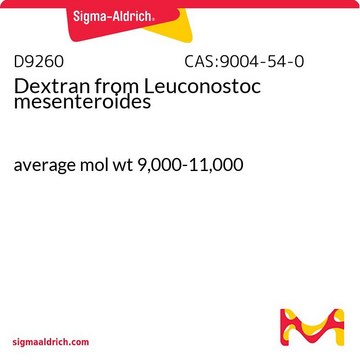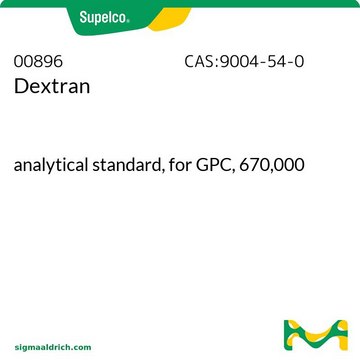31422
Dextran aus Leuconostoc mesenteroides
analytical standard, for GPC, Mw 150,000
About This Item
Empfohlene Produkte
Qualität
analytical standard
for GPC
Qualitätsniveau
Mol-Gew.
Mn ~100,000
Mp ~125,000
Mw ~150,000
chemische Klasse(n) des Analyten
oligosaccharides
Methode(n)
gel permeation chromatography (GPC): suitable
Mw/Mn
~1.50
Anwendung(en)
food and beverages
Format
neat
InChI
1S/C18H32O16/c19-1-5(21)9(23)10(24)6(22)3-31-17-16(30)14(28)12(26)8(34-17)4-32-18-15(29)13(27)11(25)7(2-20)33-18/h1,5-18,20-30H,2-4H2
InChIKey
FZWBNHMXJMCXLU-UHFFFAOYSA-N
Suchen Sie nach ähnlichen Produkten? Aufrufen Leitfaden zum Produktvergleich
Allgemeine Beschreibung
Dextran from Leuconostoc mesenteroides (Mw: 150,000) may be used as an analytical standard to calibrate the column for gel permeation chromatography (GPC).
Anwendung
Lagerklassenschlüssel
11 - Combustible Solids
WGK
WGK 2
Persönliche Schutzausrüstung
Eyeshields, Gloves, type N95 (US)
Analysenzertifikate (COA)
Suchen Sie nach Analysenzertifikate (COA), indem Sie die Lot-/Chargennummer des Produkts eingeben. Lot- und Chargennummern sind auf dem Produktetikett hinter den Wörtern ‘Lot’ oder ‘Batch’ (Lot oder Charge) zu finden.
Besitzen Sie dieses Produkt bereits?
In der Dokumentenbibliothek finden Sie die Dokumentation zu den Produkten, die Sie kürzlich erworben haben.
Kunden haben sich ebenfalls angesehen
Unser Team von Wissenschaftlern verfügt über Erfahrung in allen Forschungsbereichen einschließlich Life Science, Materialwissenschaften, chemischer Synthese, Chromatographie, Analytik und vielen mehr..
Setzen Sie sich mit dem technischen Dienst in Verbindung.














